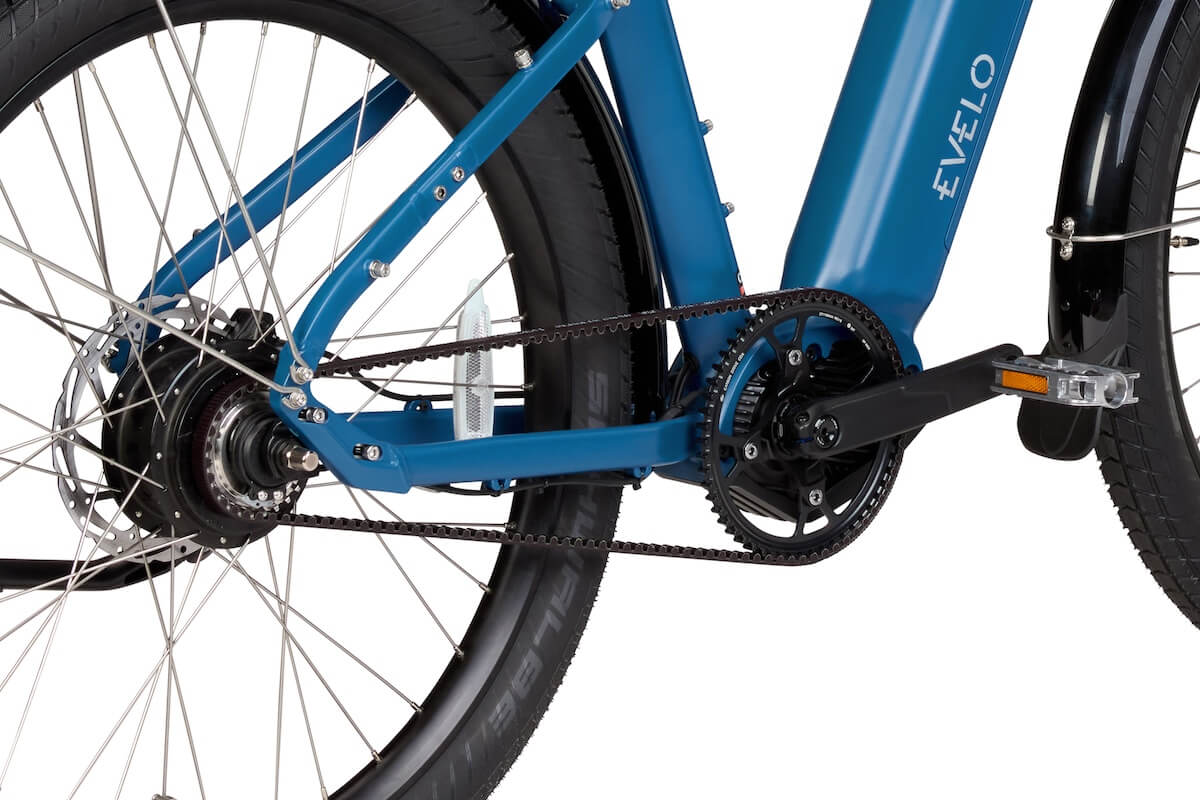What Is a Gates Carbon Belt Drive and Why Do eBikes Use It?
Bicycle drivetrains traditionally are designed around chains. A chain has moving metal links that engage on the teeth of a metal gear, and in order to keep wear at a minimum, the parts have to be clean and lubricated.
The Gates Carbon Belt Drive is an alternative that uses a carbon-reinforced polyurethane belt that engages on metal gears. There are many benefits to using a system like this, but the main two are lower maintenance and longer lasting. We will dive into a few more benefits of the belt and also dive into some less often discussed nuances of chain versus belt drive.

Bicycle Drivetrains
It is important to first establish that there are two types of chain-driven drivetrains, while there is only one belt-driven type. A chain can be used with a cassette/derailleur-type gear system, and also an internally geared version.
The most common type is the cassette/derailleur type drivetrain, which is the least robust of all of them and requires the most maintenance. The derailleur needs to be properly aligned and adjusted for proper function. Cable stretch, impact, rough handling/transport, and proper maintenance make a big difference in performance, which often is the source of a rider’s aggravation.
There are two benefits of the cassette/derailleur type drivetrain: lightweight and, for the high-end components, better suited for aggressive shifting. This suits high-performance riding better at the expense of wearing out parts. For the average user, this means more work, less riding.
An internally geared hub (IGH) is a transmission that houses the gears inside the hub shell. This design is lower maintenance and more durable because the gear system is protected from the elements. There is no derailleur that hangs down on these drivetrains, even when using a chain, which also makes for less chance of damage. The chain still needs regular cleaning and lubricating in these drivetrains, but so much less that internally geared hubs are very useful on ebikes. This means more riding and less maintenance.
A Gates Carbon Belt can be paired with an IGH gear system, but not a cassette/derailleur system. When we talk about belt drive, we are automatically talking about a drivetrain that benefits from all the things an IGH provides, which are less maintenance and longer product life.
The Gates Carbon Belt will further amplify these things; it requires no lubricating, therefore no cleaning, and also will last 4-8 times as long as a chain. The lowest maintenance drivetrain you could have on an ebike is a Gates Carbon Belt paired to an internally geared hub. This means even less maintenance and more riding.
Gates Carbon Belt benefits for Ebikes
Mid-drive ebikes really benefit from the carbon belt system because they see higher loads on the drivetrain. This wears out a chain in 1000-2000 miles, while a belt will last 10,000 miles or more.
Normally, the need for cleaning, lubricating, and replacing the chain would be dramatically increased on a mid-drive ebike, but using a belt instead of a chain means the service intervals are not as frequent, and most customers never replace a belt on a bike during their whole ownership. The lower maintenance and longer product life are especially noticeable on the ebike platform.
A belt is also quiet and clean. While riding, you will not hear the belt, which makes the ebike quieter than a chain-driven counterpart. This factor is often overlooked until someone is on a belt-driven bike and realizes the absence of chain noise.
The belt does not stretch with use, which is a major factor in keeping the drivetrain silent; the belt and gears will mesh quietly and smoothly for thousands of miles while a chain progressively gets louder and worse shifting with miles.
Since the belt needs no lubrication, there is no grime/dirt attraction to the belt, and therefore, it stays clean. This makes transportation and storage easier because there is no mess when you touch or rub your pants/leg against the drivetrain. For folks who put a bike inside a car or store a bike inside their home, this is especially helpful.

Why Doesn't Every Bike Use Gates Carbon Belt Drive
In order to fit a Gates Carbon Belt Drive on a bike, the frame has to be designed around the belt, and a belt-compatible motor has to be used. The entire bike is designed around this system, which means that in most cases, you cannot convert an existing bike over to a belt drive.
For a belt to work properly, the alignment of the front and rear gears has to be perfect, which means the motor has to have the right offset to match the rear hub offset. This determines the powerplant for the bike, and the frame geometry is then designed around that. The frame also needs a spot where it can split so the belt can be installed. Doing all of this is harder and more expensive than a chain-driven bike, and that keeps many manufacturers from using the belt.
A belt drive and IGH drivetrain is really good to use on an ebike, commuter bike, or leisure bike where light weight and fast/aggressive shifting are not necessary, and instead durability and lower maintenance are valued. The majority of riders in the bicycle world fall in this category because even if we think we are performance riders, we are probably not.
An amateur or professional racer would not want these parts on their bicycles because they want to shift faster and under load for performance reasons. Modern high-end shifters/derailleurs for chain gear systems are designed so they can shift under load; however, they will wear quickly when operated like that. There are pros and cons to each system, which is why, yet again, not every bike has a carbon belt on it.

